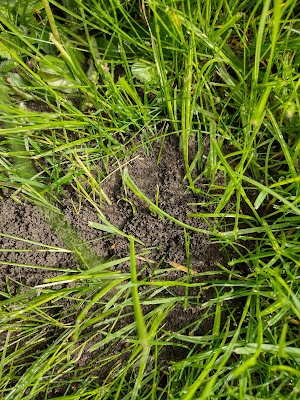I have what can laughingly be described as a wildflower meadow. But it works. In the middle of the circular lawn in our small semi rural garden, over the last five years I've developed this meadowland. I say meadowland but in reality it is a 2m circle of not cutting the grass until August with additional planting.
The planting here is a mix of naturalising garden bulbs, snowdrop and crocus first, followed by daffodil and tulip. Lesser celendine, primrose, dandelion and cowslip are also present and encouraged. Later in the year fox and cubs will dominate before the grasses overtake everything. This year I was thrilled to see my alba fritillary in flower. This was especially joyous as I bought 12 dried shriveled corms last October for 50p, mostly as I don't like to see garden centres throwing out unsold stock. Despite these dessicated specimens looking truly dire, I planted them and crossed my fingers.
Of the twelve corms planted seven flowered. I'm hopeful then they will survive in the heavy clay, though not waterlogged, soil under the lawn.
Despite its insignificant size I love this little slice of unkempt in the garden, it changes by the week. To be honest the entire garden is wildlife friendly as Mrs Wessex Reiver being a professional plantswoman is of the organic persuasion. As am I.
The longer grass allows a small yellow meadow ant (Lasius flavus) colony to exist. Their soil 'molehill' is on sunny days alive with activity as the ants emerge from underground. Snails of all differing shapes and colours love the cover and humid vegetation too, a topic maybe for another day. But it is the accidental finds that enrich this corner of Somerset's biodiversity.
Yesterday after watching a little of the Coronation we spent an hour or so fettling the garden. It was while doing this I noticed a pair of orange bugs upto naughties in the long grass. I had an inkling what they were but thanks to the power of Google Lens, which is an amazing bit of technology, they were confirmed as cinnamon bugs (Corizus hyoscyami). I've never seen this bug species in the garden before. Difficult to photograph in situ so after they'd ahem finished I tried to do better by placing them in a plant saucer. Not great but enough to identify them. I then returned them.
I'm no entomologist so reading up on these beautiful looking bugs I noted that until recently they were localised in sandy habitats around the coasts of southern Britain, but recently (climate change?) this species range is expanding north and into an eclectic mix of habitats inland. So that's why they're in my garden. It's an eclectic habitat! And they weren't the only recent arrival to the garden.
Earlier in the week I stood admiring the cowslip, which from one self seeded plant three years ago now number around a dozen. On one stem was a jewel-like blue beetle, resembling a dark blue marble with legs. Various ground beetles went through my mind but I had a notion this was different.
And it was. Thanks to my go-to encyclopaedia of all British wildlife, Brett, he confirmed what I'd half thought; (Agelastica alni), the alder leaf beetle. Wow. I say wow as this beetle was thought extinct in the UK. Then in 2004 it was found in Manchester, seemingly brought in on plant stock imports. From there it slowly spread across the north midlands, before being found in a second area in southern England around a decade ago. It is spreading.
Brett informed me there is a very healthy population on the Somerset Levels where there is unsurprisingly a large number of alder. As they fly he suggested, despite no alders being near our garden, the one on my cowslip would be flight-resting between alders. Fascinating.
Definitely a first for the garden. I've not seen it since that day, assuming therefore its onwards travel to an alder has taken place.
But all this goes to show, a tiny bit of wild meadow even in a small garden can attract the most interesting of discoveries. I wonder what the next rarity will be? Osprey maybe on the 40cm pond?











A beautiful patch of wildlfower meadow Andrew. We have one here too - at the moment it is full of cowslips :) As you demonstrate you can spend hours looking at the wild flowers and studying the insects. Every garden should have one. Great sighting re: the cinammon bugs and good news the alder leaf beetle is spreading. A very interesting and thought provoking post :)
ReplyDeleteI do love cowslips. It really is staggering how something of such a small size can make such a difference. I'll need to look at the plants next as things are springing up that I have no idea what they are. We can all do our little bit.
ReplyDeleteAh but every little helps! If everyone did it, instead of that horrid artificial grass
ReplyDelete